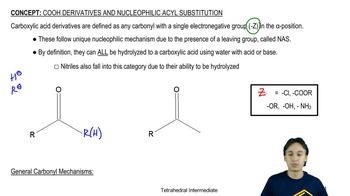Predict the products of the following reactions.
(a) phenol + acetic anhydride
(b) phenol + acetic formic anhydride
(c) aniline + phthalic anhydride

 Verified step by step guidance
Verified step by step guidance Verified video answer for a similar problem:
Verified video answer for a similar problem:



 9:32m
9:32mMaster NAS - The Three Rules with a bite sized video explanation from Johnny
Start learning